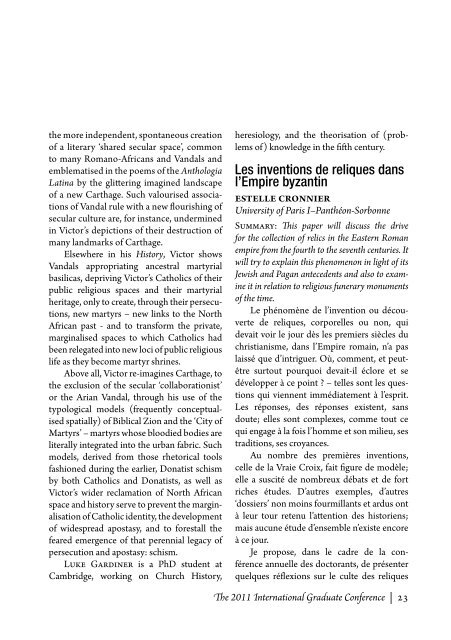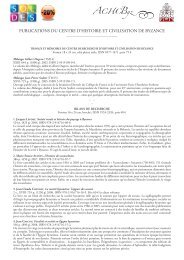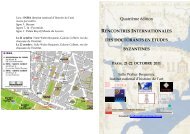booklet of abstracts - Oxford University Byzantine Society
booklet of abstracts - Oxford University Byzantine Society
booklet of abstracts - Oxford University Byzantine Society
Create successful ePaper yourself
Turn your PDF publications into a flip-book with our unique Google optimized e-Paper software.
the more independent, spontaneous creation<strong>of</strong> a literary ‘shared secular space’, commonto many Romano-Africans and Vandals andemblematised in the poems <strong>of</strong> the AnthologiaLatina by the glittering imagined landscape<strong>of</strong> a new Carthage. Such valourised associations<strong>of</strong> Vandal rule with a new flourishing <strong>of</strong>secular culture are, for instance, underminedin Victor’s depictions <strong>of</strong> their destruction <strong>of</strong>many landmarks <strong>of</strong> Carthage.Elsewhere in his History, Victor showsVandals appropriating ancestral martyrialbasilicas, depriving Victor’s Catholics <strong>of</strong> theirpublic religious spaces and their martyrialheritage, only to create, through their persecutions,new martyrs – new links to the NorthAfrican past - and to transform the private,marginalised spaces to which Catholics hadbeen relegated into new loci <strong>of</strong> public religiouslife as they become martyr shrines.Above all, Victor re-imagines Carthage, tothe exclusion <strong>of</strong> the secular ‘collaborationist’or the Arian Vandal, through his use <strong>of</strong> thetypological models (frequently conceptualisedspatially) <strong>of</strong> Biblical Zion and the ‘City <strong>of</strong>Martyrs’ – martyrs whose bloodied bodies areliterally integrated into the urban fabric. Suchmodels, derived from those rhetorical toolsfashioned during the earlier, Donatist schismby both Catholics and Donatists, as well asVictor’s wider reclamation <strong>of</strong> North Africanspace and history serve to prevent the marginalisation<strong>of</strong> Catholic identity, the development<strong>of</strong> widespread apostasy, and to forestall thefeared emergence <strong>of</strong> that perennial legacy <strong>of</strong>persecution and apostasy: schism.Luke Gardiner is a PhD student atCambridge, working on Church History,heresiology, and the theorisation <strong>of</strong> (problems<strong>of</strong>) knowledge in the fifth century.Les inventions de reliques dansl’Empire byzantinEstelle Cronnier<strong>University</strong> <strong>of</strong> Paris I–Panthéon-SorbonneSummary: This paper will discuss the drivefor the collection <strong>of</strong> relics in the Eastern Romanempire from the fourth to the seventh centuries. Itwill try to explain this phenomenon in light <strong>of</strong> itsJewish and Pagan antecedents and also to examineit in relation to religious funerary monuments<strong>of</strong> the time.Le phénomène de l’invention ou découvertede reliques, corporelles ou non, quidevait voir le jour dès les premiers siècles duchristianisme, dans l’Empire romain, n’a paslaissé que d’intriguer. Où, comment, et peutêtresurtout pourquoi devait-il éclore et sedévelopper à ce point ? – telles sont les questionsqui viennent immédiatement à l’esprit.Les réponses, des réponses existent, sansdoute; elles sont complexes, comme tout cequi engage à la fois l’homme et son milieu, sestraditions, ses croyances.Au nombre des premières inventions,celle de la Vraie Croix, fait figure de modèle;elle a suscité de nombreux débats et de fortriches études. D’autres exemples, d’autres‘dossiers’ non moins fourmillants et ardus ontà leur tour retenu l’attention des historiens;mais aucune étude d’ensemble n’existe encoreà ce jour.Je propose, dans le cadre de la conférenceannuelle des doctorants, de présenterquelques réflexions sur le culte des reliquesThe 2011 International Graduate Conference | 23





